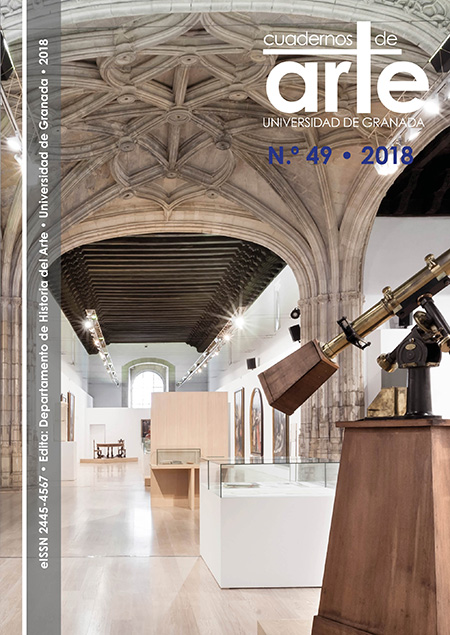Dionisio Ridruejo y sus ideas artísticas en el marco del primer franquismo
DOI:
https://doi.org/10.30827/caug.v49i0.7759Palabras clave:
Franquismo, revistas culturales, arte político, Eugenio d’Ors, Bienal de Venecia, revista Escorial, Revista, Dionisio RidruejoResumen
Se estudia en este artículo la aportación del intelectual español Dionisio Ridruejo al mundo de las artes durante los años cuarenta y cincuenta (primer franquismo). El objetivo fundamental de esta investigación ha sido el analizar y ubicar el pensamiento artístico de Ridruejo en el difícil y cambiante contexto cultural de la dictadura franquista, atendiendo además a su postura disidente que acabará en clara confrontación con el Régimen. El estudio recoge tres momentos fundamentales de su trayectoria intelectual durante este periodo: el primero corresponde a los años en los que dirige la revista Escorial, el segundo a su estancia en Roma como corresponsal del periódico Arriba, y el último, a los años durante los cuales dirigió Revista, de Barcelona.
Descargas
Citas
Díaz, E. (1973). Notas para una historia del pensamiento español actual. Sistema (1), 107-132.
Escorial (1940). Manifiesto Editorial. Escorial, tomo I, cuaderno I, 7-12.
Gracia, J. (2006). Estado y cultura. Barcelona: Anagrama.
Iáñez Pareja, E. (2008). Falangismo y propaganda cultural en el «Nuevo Estado». La revista Escorial 1940-1950. Granada: Editorial de la Universidad de Granada.
Juliá, S. (2005). Historia de las dos Españas, Madrid: Taurus.
Morente, F. (2011). Corresponsal en Roma. Dionisio Ridruejo y la Italia de la Guerra Fría (1948-1951). En F. Gallego, y F. Morente. Rebeldes y reaccionarios. Intelectuales, fascismo y derecha radica en Europa. Barcelona: El Viejo Topo.
Ridruejo, D. (1949). Dalí con sus pinceles a la puerta de la Iglesia. Arriba.
Ridruejo, D. (1950a). España que podía y no quiso. Una visita a la Bienale de nuestro corresponsal. Arriba, 3.
Ridruejo, D. (1950b). Visita a la Bienal (II). Las intenciones. Arriba, 3 y 6.
Ridruejo, D. (1950c). El cine español logra en Venecia un éxito y un fracaso. Arriba, 3.
Ridruejo, D. (1951a). Benedetto Croce, el gran viejo. Arriba.
Ridruejo, D. (1951b). El neo-realismo italiano adolece de insinceridad. Arriba.
Ridruejo, D. (1951c). Caravaggio, todo junto. Arriba.
Ridruejo, D. (1951d). La campaña de los mediocres. Correo Literario (37-38), 9.
Ridruejo, D. (1952). Ante la XXVI Bienal de Venecia. Revista (5), 9.
Ridruejo, D. (1954a). El maestro (notas para una valoración de la obra de Eugenio d’Ors). Revista (92), 9.
Ridruejo, D. (1954b). Arte social. Revista (97), 9.
Ridruejo, D. (1960). En algunas ocasiones (Crónicas y comentarios 1943-1960). Madrid: Aguilar.
Ridruejo, D. (1973). La vida intelectual española en el primer decenio de la postguerra (Triunfo, nº 507, 1972). En D. Ridruejo. Entre Literatura y Política (p. 15). Madrid: Seminarios y Ediciones, S. A.
Ridruejo, D. (1976). Casi unas memorias (ed. de César Armando Gómez). Barcelona: Planeta.
Sánchez Mazas, R. (1942). Textos sobre una política de arte. Escorial (24), 3-21.
Vivanco, L. F. (1940). El arte humano. Escorial (I), 141-150.
Vivanco, L. F. (1949). Realidad e irrealidad en el arte abstracto. Escorial (62), 537-544.
Descargas
Publicado
Cómo citar
Número
Sección
Licencia
Los autores que publican en esta revista están de acuerdo con los siguientes términos:- Los autores conservan los derechos de autor y garantizan a la revista el derecho de ser la primera publicación del trabajo al igual que ser licenciado bajo una licencia Creative Commons que permite a otros compartir el trabajo con un reconocimiento de la autoría del trabajo y la cita de la fuente original, con un uso no comercial y siempre que no se hagan obras derivadas.
- Los autores pueden establecer por separado acuerdos adicionales para la distribución no exclusiva de la versión de la obra publicada en la revista (por ejemplo, situarlo en un repositorio institucional o publicarlo en un libro), con un reconocimiento de su publicación inicial en esta revista.
- Se permite y se anima a los autores a difundir sus trabajos electrónicamente (por ejemplo, en repositorios institucionales o en su propio sitio web) antes y durante el proceso de envío, ya que puede dar lugar a intercambios productivos, así como a una citación más temprana y mayor de los trabajos publicados (Véase The Effect of Open Access) (en inglés).






 ISSN-e: 2445-4567
ISSN-e: 2445-4567








